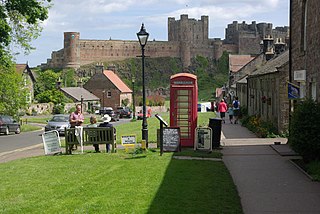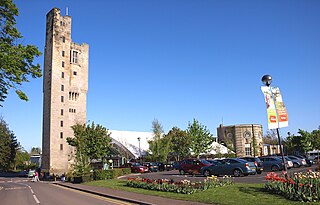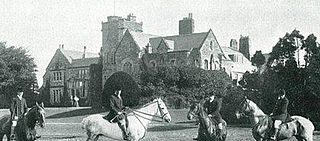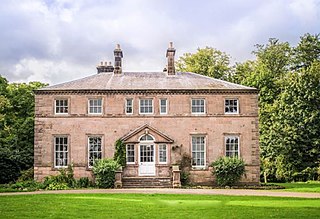
Bamburgh is a village and civil parish on the coast of Northumberland, England. It had a population of 454 in 2001, decreasing to 414 at the 2011 census.

The National Trust, formally the National Trust for Places of Historic Interest or Natural Beauty, is a charity and membership organisation for heritage conservation in England, Wales and Northern Ireland. In Scotland, there is a separate and independent National Trust for Scotland.

Bamburgh Castle is a castle on the northeast coast of England, by the village of Bamburgh in Northumberland. It is a Grade I listed building.

Seaton Delaval Hall is a Grade I listed country house in Northumberland, England, near the coast just north of Newcastle upon Tyne. Located between Seaton Sluice and Seaton Delaval, it was designed by Sir John Vanbrugh in 1718 for Admiral George Delaval; it is now owned by the National Trust.

Ellingham is a civil parish in Norfolk, England. It covers an area of 5.61 km2 (2.17 sq mi) and had a population of 532 in 238 households at the 2001 census, the population increasing to 554 in 248 households at the 2011 census. It lies approximately 2 miles (3.2 km) from Bungay and 4 miles (6.4 km) from Beccles. Other close towns to the village include Diss and Gt. Yarmouth.

Shilbottle is a village in Northumberland, north-east England, 3 miles (4.8 km) south-east of Alnwick, and 5 miles (8 km) from the coast at Alnmouth, close to the A1.

Kirkley Hall is a 17th-century historic country mansion and Grade II listed building in Northumberland, England. The estate is over 190 acres (0.77 km2) and adjoins the River Blyth at Kirkley, three miles north of Ponteland in the heart of the Northumberland countryside, which is now a Horticultural and Agricultural training centre.

Hollin Hall was an 18th-century plantation house three miles (5 km) southwest of Alexandria in Fairfax County, Virginia. George Mason, a United States Founding Father, gave Hollin Hall to his third son, Thomson Mason, through deeds of gift in 1781 and 1786. The land, as given, totalled 676 acres (2.74 km2). Thomson Mason was the first member of the Mason family to actually live here. Before then, tenants farmed the property.

Dissington Hall is a privately owned country mansion situated on the banks of the River Pont at North Dissington, Ponteland, Northumberland, England. It is a Grade II* listed building.

Haggerston Castle was a castle located in the county of Northumberland,England at Haggerston about 5 miles (8 km) south of Berwick-upon-Tweed. Only the tower, rotunda and stable block remain. Today it is part of a caravan park owned by Haven Holidays.

Lemmington Hall is an 18th-century country mansion incorporating a 15th-century tower house, situated near Edlingham, Northumberland, England. It is a Grade II* listed building. The original tower house built for the Beadnall family in the early 15th century was a four-storey construction which was reduced in height in the 17th century when Nicholas Fenwick converted the building into a country house.

Blyth Power Station refers to a pair of now demolished coal-fired power stations, which were located on the Northumberland coast in North East England. The two stations were built alongside each other on a site near Cambois in Northumberland, on the northern bank of the River Blyth, between its tidal estuary and the North Sea. The stations took their name from the town of Blyth on the opposite bank of the estuary. Blyth A Power Station was built and opened first but had a smaller generating capacity than its sister station, Blyth B Power Station, which was built to its west four years later. The power stations' four large chimneys were a landmark of the Northumberland skyline for over 40 years; the A Station's two chimneys each stood at 140 metres (460 ft); the B Station's two chimneys were taller, at 170 metres (560 ft) each.

Leighton Hall is an estate located to the east of Welshpool in the historic county of Montgomeryshire, now Powys, in Wales. Leighton Hall is a listed grade I property. It is located on the opposite side of the valley of the river Severn to Powis Castle. The Leighton Hall Estate is particularly notable for the Hall which was decorated and furnished by the Craces to designs by Pugin in his Houses of Parliament style, and for the Home Farm, a model farm, which was to be in the forefront of the Victorian industrialised High Farming. Leighton Hall was also the birthplace of the much disparaged hybrid Cupressocyparis leylandii hedge tree. The Hall is now in private ownership and is not accessible to the public, although it can still be viewed from the road. The Home Farm is currently under restoration.

Haggerston is a locale in East London, England, centred approximately on Great Cambridge Street. It is within the London Borough of Hackney and is considered to be a part of London's East End. It is about 3.1 miles (5 km) northeast of Charing Cross.

Haggerston is a hamlet located in the county of Northumberland, England about 5 miles (8 km) south of Berwick-upon-Tweed and adjacent to the A1 road. Historically, it was a baronetcy in the civil parish of Ancroft, then located in County Durham. Today, it is best known for Haggerston Castle caravan park.

Fitznells Manor is the last surviving manor house in the borough of Epsom and Ewell in Surrey, England. It is a Grade II listed building.

Ellingham Hall is an historic country house in the English county of Norfolk, near the town of Bungay, about 120 miles (190 km) northeast of London. It is located just north of the border with Suffolk and is sometimes misdescribed as lying in that county. It is situated in 600 acres (240 ha) of countryside in the Waveney Valley just outside the village of Ellingham.

Wyresdale Park is an English country house and licensed wedding ceremony venue located within the Forest of Bowland to the northeast of Scorton, Lancashire, England.

Otterburn Hall is an English country house and estate in Otterburn, Northumberland. It is situated in 500 acres (200 ha) of deer park and woodland in the Northumberland National Park, northeastern England. The building was constructed in 1870 for Lord James Douglas, the land given to him as recompense for the death of Lord James Douglas, who fought at the Battle of Otterburn, and was killed near Otterburn Tower, itself founded in 1086, and rebuilt in 1830. Both Otterburn Hall and Otterburn Castle have been seats of landed gentry.

Charlton Hall near Ellingham, Northumberland is a building of historical significance and is listed on the English Heritage Register. It was built in the late 18th Century by the notable architect William Newton for the Cay family. It was the residence for several prominent people over the next three centuries and is now a luxury wedding venue.





















